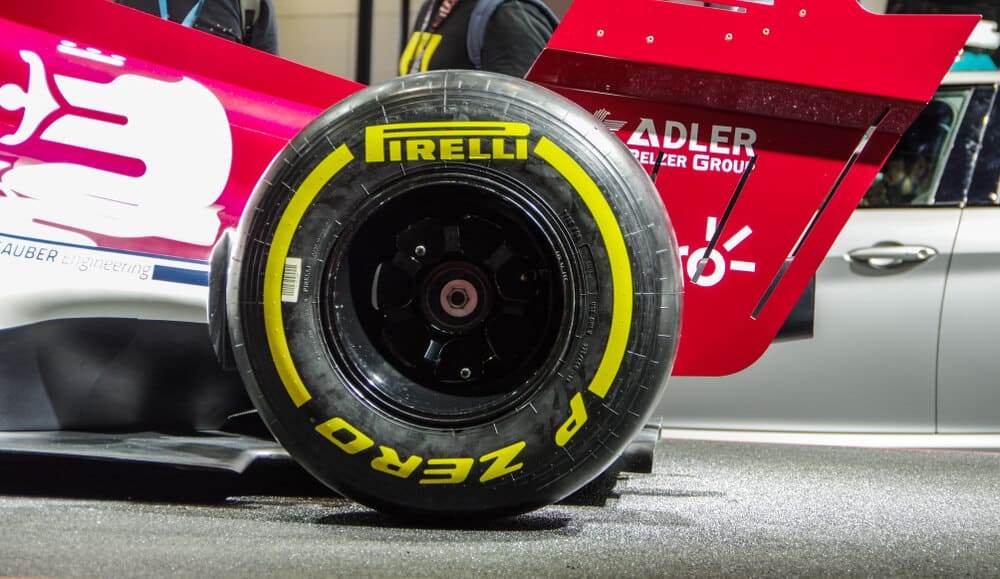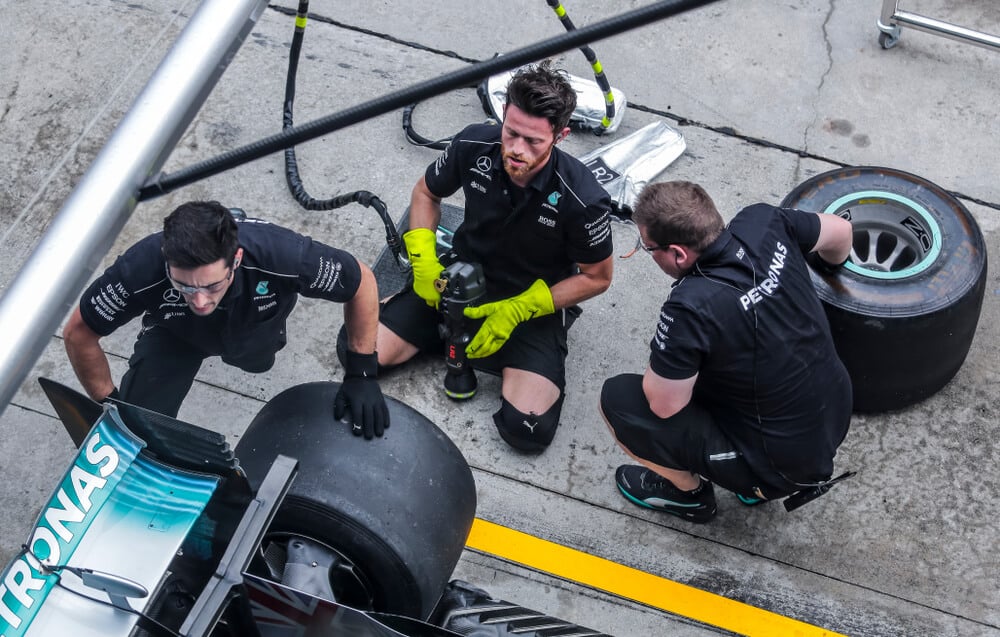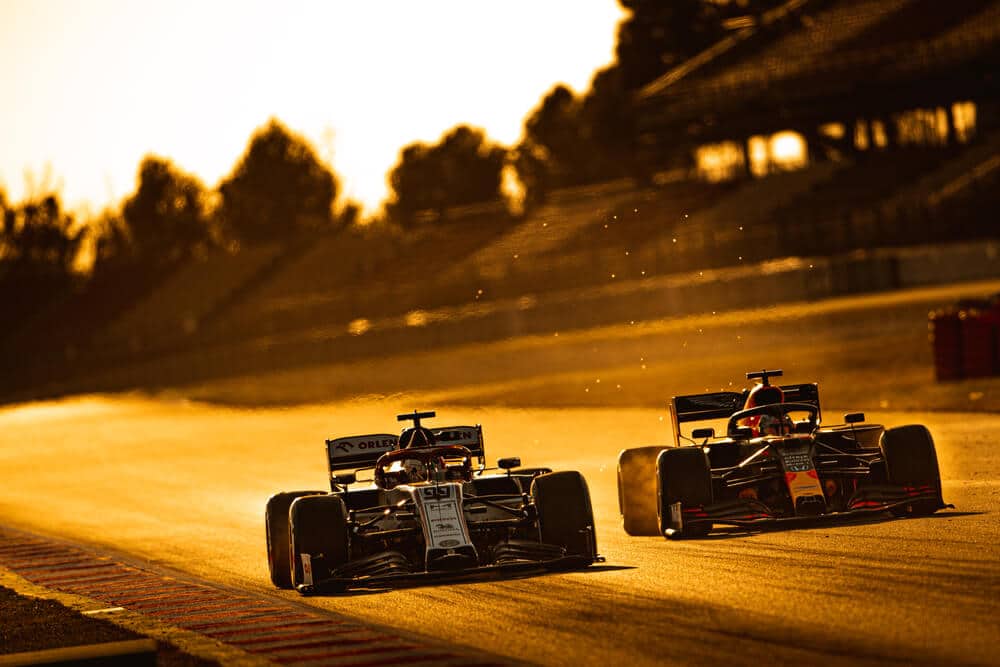One of the most important components of any Formula One car is the tyres. They are responsible for providing grip and stability when the car is cornering, braking and accelerating. What if those tires weren’t able to perform as expected?
This is where tyre degradation (deg) comes in. You must’ve heard commentators and F1 teams talk about tyre deg? This isn’t just a fancy term they use to talk about tyres, it is an important concept in Formula One.
In this article, we’ll take a closer look at what tyre deg is, how it affects a car’s performance and how teams manage it.
Table of Contents
Watch this video to learn more about Deg.
What is Tyre Degradation?
Many people often confuse tyre degradation and tyre wear. However, they are two different concepts in Formula One racing.
Tyre degradation (deg) is the thermal performance of a car’s tyres, i.e. how fast the tyre loses performance due to a certain condition or driving style. On the other hand, tire wear refers to the physical wearing out of a tyre over time and use.
Deg can affect the race performance of an F1 car significantly. It could result in a loss of grip, stability, and overall speed. Because of this, teams must manage their tires as they compete to ensure that they have the best possible performance.
Definition of Tyre Degradation
Deg is an overall decrease in performance of the tyres due to an imbalance of temperature. The temperature imbalance occurre when they are either over or under heated. This results in a longer lap time and overall performance.
Overview of Tyre Degradation in Formula One
In Formula One, the tyres are subjected to a lot of forces and temperatures due to the speeds they travel. This can result in an imbalance of temperature, which in turn can cause the tyre to overheat or underheat and that’s where tyre degradation (deg) comes in.
The balance of temperature is very important in Formula One, as it affects the tyres’ performance. If they are too hot or too cold, the tyre’s grip and stability will be compromised and degradation of the tyre will be higher. This can affect a car’s lap time and results on race day.
Deg is caused by a number of factors, the most common being ambient temperature, construction of the tyres and the compound used. Teams must carefully monitor these factors and manage their tyres to ensure the best performance.
Key takeaways
Here are the key aspects that you should know regarding tyre degradation (deg) in Formula One:
- Tyre degradation (deg) is an overall decrease in performance due to an imbalance of temperature.
- Tyre wear and tyre degradation are two different concepts in F1 racing.
- Factors like ambient temperature, construction, and compound influence tyre deg.
- Tyre degradation can affect a car’s performance, resulting in longer lap times and poor results.
- Tyre degradation can be minimized through proper tyre management.
- Teams and drivers must constantly adjust to the changing conditions during a race in order to control tyre degradation.

Causes of Tyre Degradation
Here are some of the causes of tyre degradation in Formula One:
Ambient Temperature
Ambient temperature refers to the air temperature surrounding the tyres. In Formula One, the tyres are subjected to extreme temperatures due to the speed of the cars. This can lead to an imbalance in tyre temperature, resulting in tyre degradation.
Higher ambient temperatures can soften the tyre compound and make it more susceptible to overheating, thus reducing grip and leading to quick tyre wear. This can have a negative effect on performance, resulting in increased lap times.
Construction of Tyres
Another factor that contributes to tyre deg in Formula One is the construction of the tyres. The F1 tyres are generally constructed with softer and more flexible rubber compounds to provide maximum grip and performance.
Although these softer compounds give the tyres more grip when racing, they also break down faster under high loads and heat generated from the extreme speeds of F1 cars. This means that the tyres require frequent replacement and is a key factor in the high rate of tyre degradation.
F1 tyre manufacturer Pirelli has been developing tyres with a focus on tyre degradation, striving to find the perfect balance between grip and performance.
Compound Used
Another factor that has a huge impact on tyre degradation in F1 is the type of compound used. There are generally three types of compounds used – soft, medium and hard, which are marked red, yellow and white respectively.
Soft tyres provide the best grip, but they also wear out faster due to their softer compound construction. Medium tyres are a compromise between the soft and hard tyres, providing decent grip with slightly better durability than the softs. Hard tyres provide the least amount of grip but last longer as they are constructed from a harder rubber compound.
These compounds all have an impact on tyre degradation as they affect the balance of temperature in the tyres. Soft tyres are more likely to overheat and degrade faster due to their soft compound construction. Hard tyres will last longer as they have a harder rubber compound but there will be less grip. Medium compounds provide a good balance between the two, but still suffer from degradation if pushed too hard.
Strategies to Reduce Tyre Degradation
Now that you know the factors that influence tyre degradation, let’s take a look at some of the strategies used by teams and drivers in order to reduce this.
Track Positioning
One of the most important strategies used to reduce tyre degradation is track positioning. Generally, drivers and teams will try to position their cars in the clean air, away from any dirt or debris that could affect the tyre temperature. This helps keep the tyres cool and minimizes overheating.
Staying in clean air also allows the driver more control over their car as it is less affected by other vehicles. This results in smoother driving which puts less strain on the tyres and helps reduce tyre wear.
Tyre Pressure
Tyre pressure is an important factor when it comes to deg in Formula 1 racing. The tyre pressure determines the contact patch of the tyre with the track. This is the area of the tire that comes in contact with the road surface.
A low pressure will create a larger contact patch, providing more grip but leading to a quicker degradation of the tire due to increased heat and friction. On the other hand, a high pressure will lead to less grip but also less wear on the tire.
Hence, F1 teams must carefully manage the tyre pressure of their tires to find the optimal balance between grip and wear. Ideal tyre pressure for a Formula 1 car is affected by many factors such as track temperature, air temperature, and weight of the car.
Driver Strategies
Since the driver is the one in control of the car, they play an important role in reducing tyre degradation. Drivers must be aware of the track conditions and adjust their driving accordingly in order to conserve the tyres as much as possible.
Drivers should use smooth inputs when driving, avoiding any sudden movements or hard acceleration/braking that can cause the tyres to overheat. This will help keep the tyres cool and reduce wear.
In addition, drivers should avoid running too close to the limit of their tyres as this can cause them to overheat quickly and degrade faster than normal.
Impact of Tyre Degradation on Performance
Now that you know what tyre degradation is and the strategies used to reduce it, let’s take a look at how it impacts performance.
Loss of Grip
The obvious impact of tyre degradation is the loss of grip. As the tyre degrades, its contact patch with the track gets smaller and thus it provides less grip. Less grip means the car is less responsive to inputs and its performance on the track decreases.
Additionally, drivers experience less confidence in their car due to the reduced grip and are often forced to make compromises in their driving in order to compensate.
Increase in Lap Times
When tyre degradation sets in, lap times suffer. This is because the grip of the tyres is reduced due to wear, causing the cars to be slower around the track.
In such cases, drivers must adjust their driving style in order to make up for the loss of grip and try to minimize the impact on lap times.
Increase in Pit Stops
Another major impact of deg is an increase in the number of pit stops. When a car experiences severe tyre degradation, it must be brought into the pits to change tyres in order to gain back some grip and performance.
The more pit stops a driver has to make, the longer it takes for them to complete a race. This can have a significant impact on their race results and overall performance.
Frequently asked questions
What is tyre degradation in Formula One?
What are the causes of tyre degradation in Formula One?
What strategies can be used to reduce tyre degradation in Formula One?
Conclusion
So, there you have it – tyre degradation in Formula One is an important aspect of the sport that must be taken into account when strategizing and driving. By understanding what causes deg, how it affects performance, teams and drivers can maximize their performance on track.
We hope that this article has given you a better understanding of tyre degradation and how it impacts performance in F1. Next time you’re watching an F1 race, take a look at how teams and drivers are managing their tyres for maximum performance.
Article sources
Learn more about Formula One
Want to learn more about F1? Then visit our Formula 1 glossary and dictionary.




